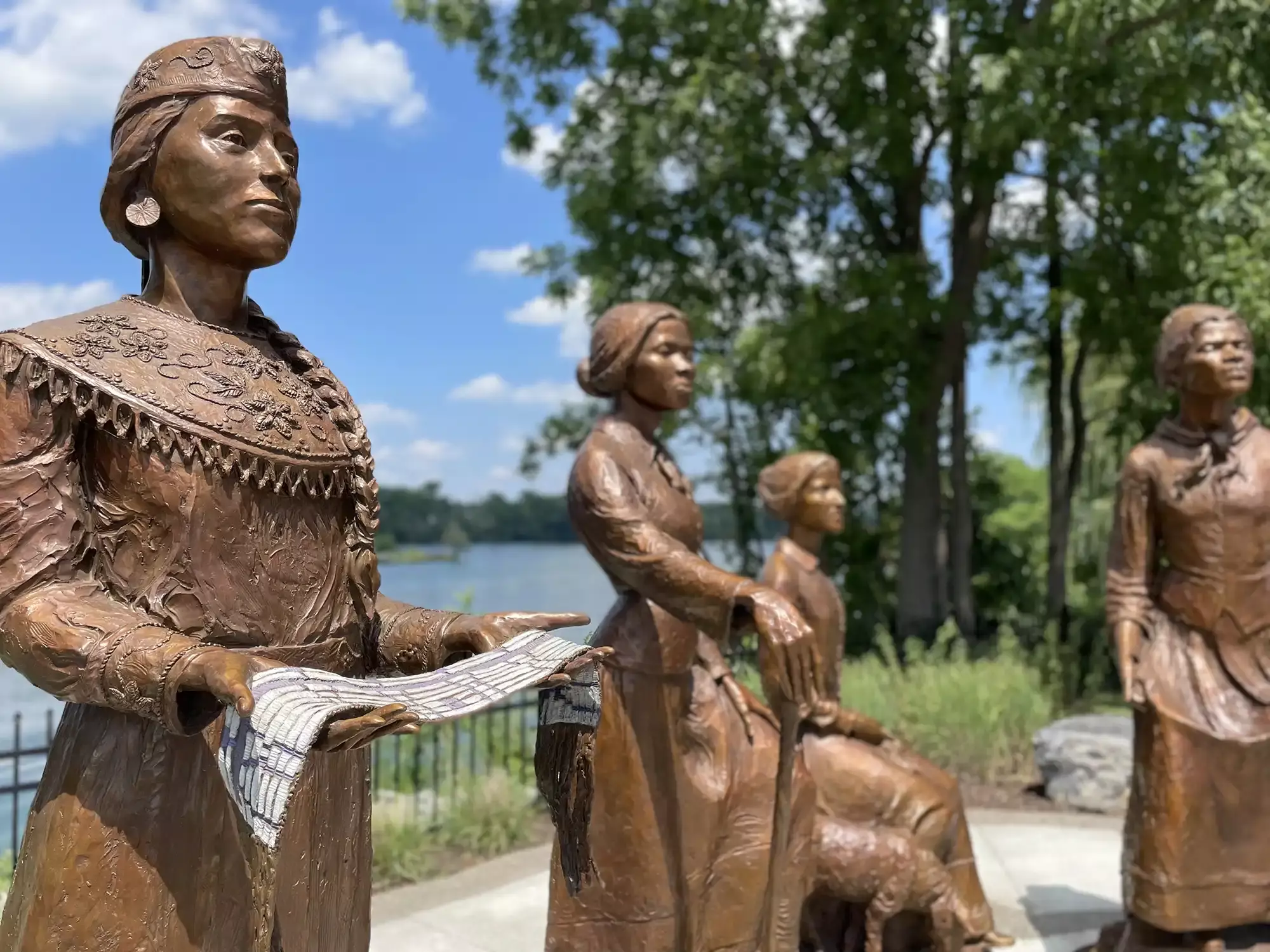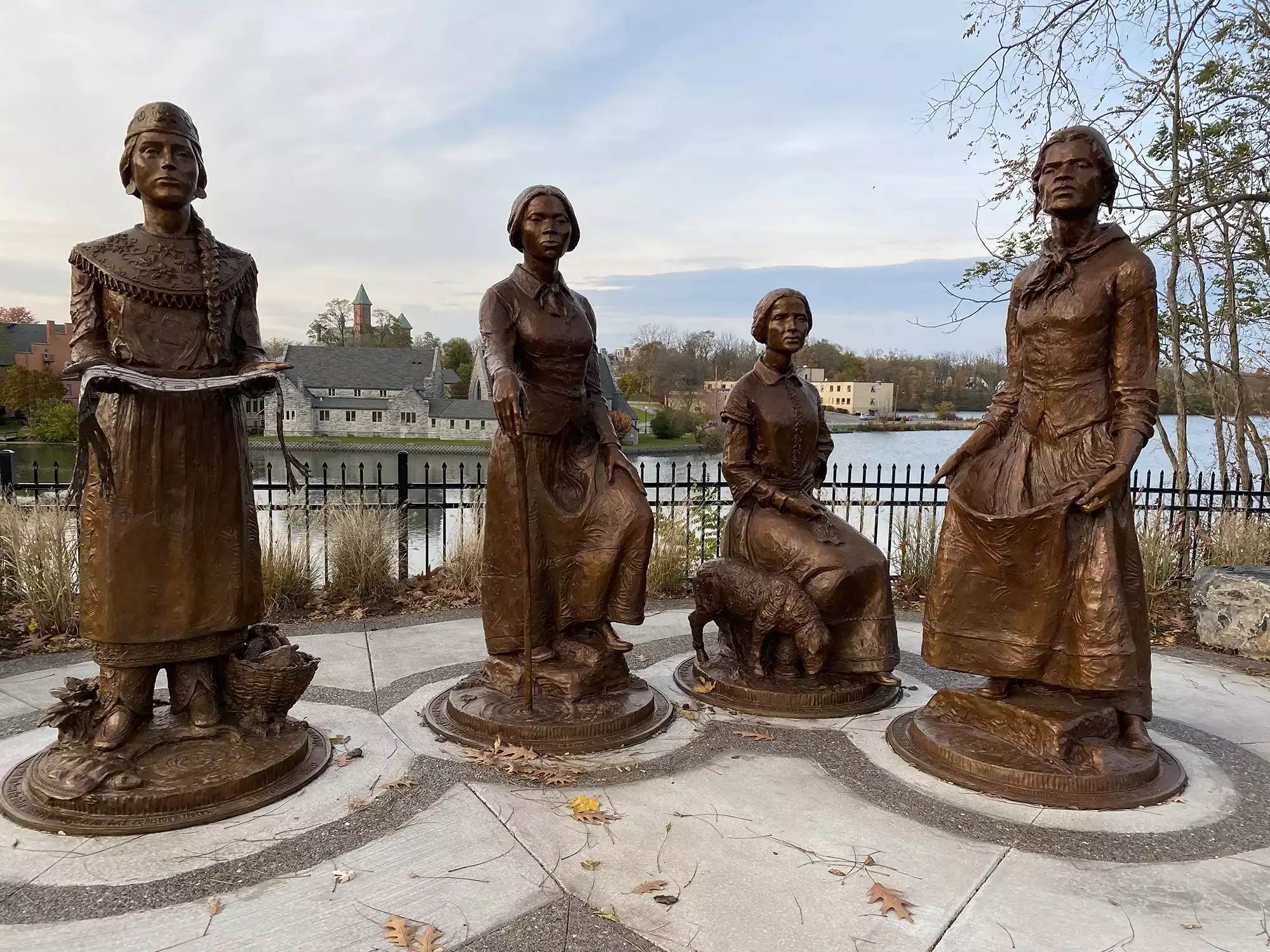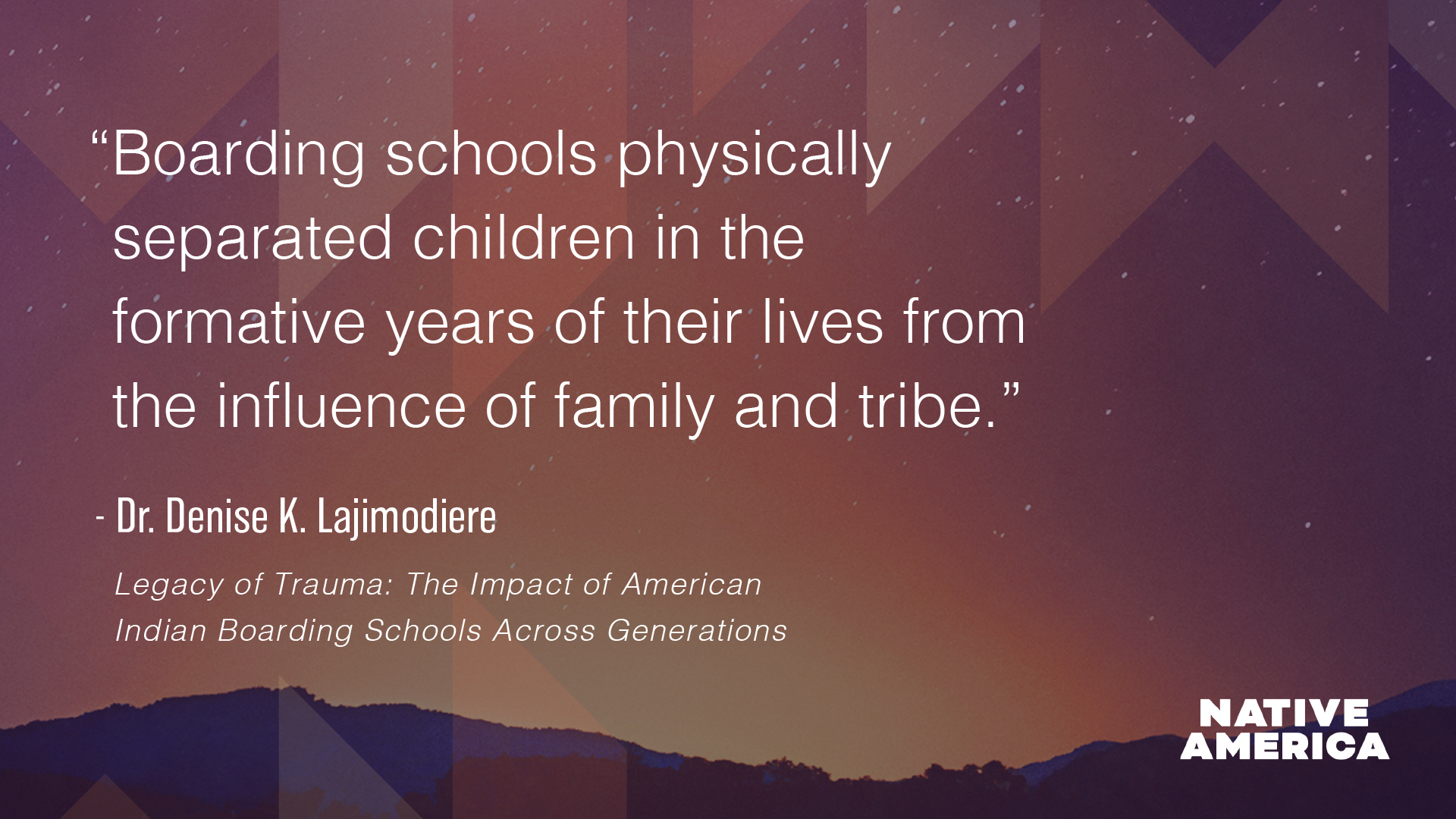Indigenous Women’s Influence on Modern Democracy and Women’s Suffrage

Michelle Schenandoah, Oneida Nation Wolf Clan, JD LLM MS in Journalism, a trained lawyer, writer, producer, and Founder of the non-profit Rematriation and Indigenous Concepts Consulting, highlights contributions of Indigenous Peoples in North America.
What is the role of Indigenous women in women’s suffrage?
“These women had to see something that tells them it's possible,” said Historian Dr. Sally Roesch Wagner in the film, Without A Whisper.
The Haudenosaunee Confederacy is the oldest continuous democracy in the world and the model for the U.S. Founding Fathers in creating the United States Constitution and its representative form of government organized on the local, state, national and international levels. The structure and form of the Haudenosaunee Confederacy, also known by the French as the “Iroquois,” has stood for well over 1,000 years. A lesser known and powerful story is that the Haudenosaunee were also the source of inspiration for the Founding Mothers of the Suffrage Movement that sparked the light for women’s rights around the world.
There is no hierarchy among our people or the Natural World. It’s often said by non-Haudenosaunee people that among the Haudenosaunee “women are equal to men.” Contrary to this western patriarchal interpretation where men are the standard, Haudenosaunee women hold an elevated and protected status as lifegivers and as the mothers who raise our nations. As Haudenosaunee women, we are however equal with men in our responsibilities to the wellbeing and peace of the people, our nations and with all living beings.
Haudenosaunee society is centered around the role of women from our Creation Story to our clan families led by our Clan Mothers, and the way we celebrate our women and girls. Our Creation Story begins with Sky Woman who was pregnant and fell from another world among the stars to this world that was completely covered with water. With the help of the water animals, her daughter and twin grandsons, our Mother Earth was formed, which we call Turtle Island.
Human beings were created by one of the twin grandsons, who also left instructions on how to live on Mother Earth with thankfulness. As humans began to make life on earth they were soon faced with death for the first time. Struck with grief and not knowing how to handle it, a young man brought forward a vision. The elder women of each family were asked to gather water at the stream and to report on the first animal they saw and which side of the stream it was located.
This animal would become that elder woman’s clan, informed which side of the longhouse that her clan would sit, and how to care for the clans on the other side of the house in times of grief. Two women reported a bear on the opposite sides of the stream. With the young man’s help, the three of them made a decision where the bear clan family would sit. This three sided decision making process continues to be the Haudenosaunee process for making decisions – passing issues back and forth across the house until we come to a consensus among our clans and nations.
To this day, the lineage of our families is passed down through the women. Our children receive our clan, name, and nation from their mother’s clan, unlike the patriarchal family structure. Haudenosaunee Clan Mothers oversee the well-being of our clan families and ultimately, our nations. She is the caretaker of her people at the local level and instructs her Chief on matters of importance that must be elevated to the national or international level.
The system of Chiefs and formal democracy among the Haudenosaunee was later brought to us by the Peacemaker under what is called Great Law of Peace. In this system, a Clan Mother selects one Chief to be the representative voice of her clan. Clan Mothers have the absolute right to remove her Chief if he acts in his own self interests and not the best interest of the peace and well-being of his people.

There are six nations among the Haudenosaunee Confederacy – the Mohawk, Oneida, Onondaga, Cayuga, Seneca and Tuscarora. A Grand Council is called when our six nations meet, and each nation sits in its designated place within the longhouse. Agendas are set and approved, and the issues among our nations or with nations outside of our Confederacy are run through this process of deliberation.
Clan Mothers advise their Chiefs on their authority over the matters discussed. Clan Mothers also decide upon matters of war and peace. The Peacemaker gave certain duties to each side, including giving one Chief the power to intervene and stop the matters when two sides cannot agree. The Grand Council works to consider the matters by intently listening to each other and coming to consensus - meaning, a decision that all nations can peacefully live with because everyone was heard, and everyone participated in the decision making process.
The roles and responsibilities of Clan Mothers and Chiefs, having three sides to our governing bodies, the process of passing matters across the house, deliberating and handling matters at local, national and international levels, and the power to intervene and veto, all existed prior to Columbus setting sail to the Americas.
The U.S. Founding Fathers studied our people closely along with our form of governance that still exists today. This history is kept among our people through oral tradition. Benjamin Franklin in his Remarks Concerning the Savages of North-America:
“The Business of the Women is to take exact notice of what passes, imprint it in their Memories, for they have no Writing, and communicate it to their Children. They are the Records of the Council, and they preserve Tradition of the Stipulations in Treaties a hundred Years back, which when we compare with our Writings we always find exact.”
When the U.S. Founding Fathers created their Constitution, modeling the Haudenosaunee form of governance, they left out the critical role of women. Abigail Adams warned her husband, the second U.S. President John Adams, about this move, “cementing a rebellion,” said Dr. Wagner. “When (white) women married, they ceased to exist legally.”
Potawatomi botanist, Robin Wall Kimmerer in "Braiding Sweetgrass" sets the stage for her book by comparing the Haudenosaunee matrilineal worldview that begins with the Creation Story of Sky Woman to that of the Christian story of Eve. One way of life uplifts women and their gift of bringing life into the world, and the patriarchal worldview forever condemning women with the physical pain and burden of childbirth because Eve ate an apple from the tree of knowledge. Women under U.S. laws were considered the property of her husband. She had no right to her children if she left her marriage, and could be physically beaten or raped by her husband.
Neighboring white women living in the colonies saw that all Haudenosaunee women had full autonomy over their minds, their bodies, their children, their homes, their possessions and authority in deciding matters over the lands of their nations.
Like the U.S. Founding Fathers, the Seneca Falls Convention organizers who began the Suffrage Movement, had first-hand knowledge of the important role of Haudenosaunee women. Wagner’s research has shown that white women felt safe among the Haudenosaunee and did not want to leave our villages. According to Wagner, Lucretia Mott spent time among the Seneca Nation and Matilda Josyln Gage was adopted into the Mohawk Nation. Gage said “never was justice more perfect, never was civilization higher.”
Awareness of the Haudenosaunee women’s influence is coming back into light. In 2021, the U.S. Congress commissioned the Ripples of Change monument that was dedicated to the lesser known stories of the Suffrage Movement. Included in the monument is Laura Cornelius Kellogg, an Oneida woman. While she was not fighting for suffrage, she supported the Suffragists during her life’s work in pursuit for land rights of the Haudenosuanee. Cornelius Kellogg was notes for saying,
“It is a cause for astonishment to us that you white women are only now, in this twentieth century, claiming what has been the Indian (Indigenous) woman’s privilege as far back as history traces.”

Among Haudenosaunee women today, we look out onto the landscape of the United States and see environmental devastation, injustice and social unrest. We know that the U.S. government is only in its infancy, and these effects are the direct result of excluding the voices of all life in its decision making process. The U.S. Founding Fathers drafted their Constitution thinking of only men like themselves.
Haudenosaunee women as lifegivers have the responsibility to care for the wellbeing of all life including, children, the seeds for our foods, and the waters - none of these were ever mentioned in the U.S. Constitution. The critical role and authority of women leadership is an essential element to maintaining a well functioning democracy that exists in balance with Mother Earth.
In the Haudenosaunee way of life, it is the longstanding principle that all our decisions consider the impacts upon seven generations into the future. The decisions we humans make today will impact our collective great-great grandchildren whom we will never walk this earth with, but they will know us by the quality of life they will come to live.
Daneto (that is all)
This oral history has been told to me by the knowledgeable holders within the Haudenosaunee Confederacy.
Additional Resources:
The World Economic Forum on the oldest democracies: the Haudenosaunee Confederacy is the oldest continuous democracy in the world, but this history is continually erased.
New York State Museum on Haudenosaunee Women’s Influence on American Women’s Suffrage Movement



